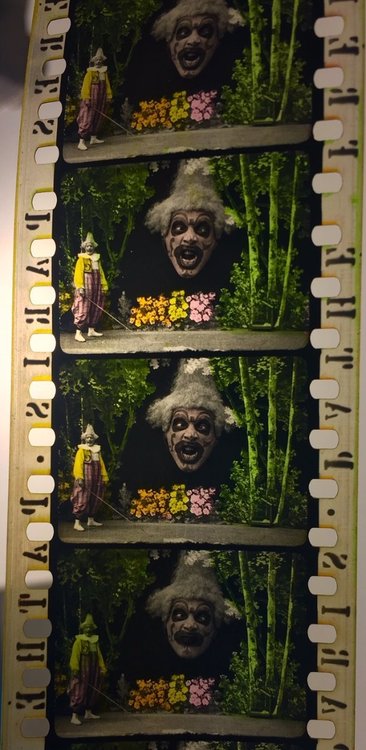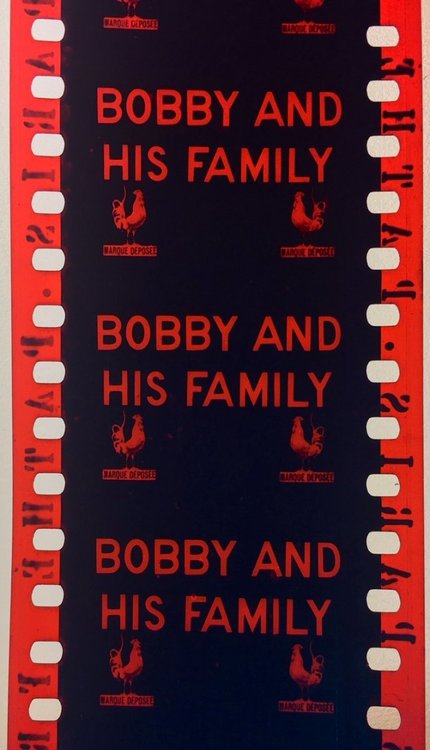-
Posts
521 -
Joined
-
Last visited
Everything posted by Frank Wylie
-
Looks like the tape was recorded on a camera with a clogged head. No cure for that... Sorry!
-

The old time animation was something...Popeye 1935
Frank Wylie replied to Daniel D. Teoli Jr.'s topic in Off Topic
Despite years of complaining to my superiors ,the samples on this page are of embarrassingly bad quality, but it is a glimpse of very early animation; https://www.loc.gov/collections/origins-of-american-animation/ -
I can't imagine the insane expectations people would have for a new camera; both cost and feature-wise. It's a no-win scenario...
-
As John says, a well seasoned, replenished developer is also well controlled and predictable. "New Soup" is hot, unbalanced and constantly varying; it is typically "seasoned" with lab short ends and (in the past) things like leader stock that is not super critical for color or density. You don't want "new soup"...
-
As hinted at before, the reference photo looks like night for day with a large light source, hanging outside, well above the windows and the room is smoked-up to define the light beams. Follow the angle of the beam from the floor to the top of the window and you'll have a line to the position of the light source outside the windows. It appears the light source is pointed toward the bottom of the outside wall, under the window, so that only spill is hitting the curtains, not the main beam. This, of course, would require quite a powerful Arc, Incandescent or HMI lamp and the rigging. A "point-source" light (bare arc) would work best, but those frosted window panes are going to cause you problems. If at all possible, temporarily remove the windows entirely, hang gauze curtains in front of the opening and make a Gobo of window pane frames behind the curtains. (Those windows look like they can be removed if they slide back and forth.) The reference photo does seem to be underexposed a bit for the interior, but shadow detail is enough that it looks like the scene was over lighted and then brought down in post.
- 5 replies
-
- 1
-

-
- lighting
- frosted windows
-
(and 1 more)
Tagged with:
-
Stabilization tools in programs like After Effects and even DaVinci Resolve make post digitization registering the images relatively simple now and then you can do a global crop on the resulting image without heavy pre-editing of individual images. You are essentially creating an electronic version of a Biograph or Kinora reel from the late 1890's. Good luck, it's going to be a lot of work.
-
Ditty bag hook. Also used for tie-downs; screw an anchor in the ground/floor and tie the tripod down.
-
"Bobby and His Family" (1906), Pathe Films, France. Thought some might be interested in seeing how well a 115 year old bit of Stencil Colored film has held up. We are getting ready to run a 4K scan on this film and I marvel at how vibrant the colors remain and just how difficult the process was to cut the stencils frame by frame to color this film. I also stumbled onto an original advertisement featuring this film; showing how film at the time was sold outright to exhibitors by the foot. The illustration is taken from, "The Red Rooster Scare: Making Cinema American, 1900-1910" by Richard Abel, if you find this interesting. (Sorry for the crappy cell phone capture, but even with this, the color is amazing...)
- 1 reply
-
- 1
-

-

When was this Spirit 4K scanner state of the art?
Frank Wylie replied to Daniel D. Teoli Jr.'s topic in Post Production
Unless you know someone who is a retired Thompson Engineer, who is willing to live in a trailer behind your house and work for food and you have 5 surplus units to scavenge, forget this scanner. They were designed for a post production house environment that flourished when money ran as freely as cocaine in the business. They are like Bugatti or McLauren cars; beautiful, fast and broken all the time. Don't get me wrong, they are great scanners but in no way are they practical in any sense for anyone less than a giant commercial company or a government institution (and not even them sometimes). -
You could probably try to apply a deflicker filter on the footage.
-
Not really, but being a lab stock, it will be really low; probably no more than the ST9...
-
? Tell me about it! 500+ features over 25 years but "publicity is not your job". I should legally change my name to "We", because "We" did all this work...
-
Roy, Try contacting Colorlab in Rockville, MD. They sell Orwo camera original stocks in their store, but might be able to get the TF12d Sound stock stock for you. In my experience, there is only minimal edge numbering on the stock and none down the center... http://colorlab.com/ourstore-film.html ORWO TF12d: http://www.filmotec.de/?cat=29&lang=en&lang=en Data sheet: http://www.filmotec.de/wp-content/uploads/2010/08/V-I-TI-TF12d-e.pdf Be forewarned that TF12d is panchromatic and must be processed in total darkness.
-
This is similar to the Le Prince / Bell and Howell theory you champion. "Le Prince vanished September, 1890 in France. I imagine he had traveled to America, lived incognito somewhere around or in Chicago, and fed his life work into the young company. Howell simply cannot have conceived so many brilliantly designed things in the pace the world was made to believe, not alone. " This statement is as equally anecdotal as the axis bomber story that has circulated for years. History is often vastly simplified and skewed toward the best interests of the author or their employer, but I have a hard time believing almost every significant technical development is cloaked in deception and skullduggery.
- 6 replies
-
- 2
-

-
- cineflex
- arri 35 copy
-
(and 2 more)
Tagged with:
-
Why change horses mid-stream? You'll have enough problems without adding a new software package to the mix. I encourage you to learn Resolve, but not under the gun...
-
I only handled one briefly in the late 1980's, but didn't shoot with it. It's more or less a direct rip-off of the original Arri 35 that was recovered from a shot down Axis bomber. As I understand it, the magazines are interchangeable between the two cameras, but not sure about anything else. In retrospect, it kind of reminds me of the build quality of a Konvas, but not quite as good.
- 6 replies
-
- 1
-

-
- cineflex
- arri 35 copy
-
(and 2 more)
Tagged with:
-
Why? I time other people's work, and as I am fond of saying, "All my clients are DEAD". I am a technician. I take great pride in my work, but it makes for poor reading.
-
God, I'd love to have a Matipo; that's my dream printer! I visited João de Oliveira's "Bat Cave" under the stairs at the BFI J. Paul Getty Center Lab in 2000 and he had a brace of the machines that he used on a regular basis. Nothing like a step contact printed release print...
-
If you are only going to digital for release, the expense and effort makes no sense. Take that from one of the few remaining Film Timers in the World. There are very good LUT packages that you can use to make your end product look like film origination IF you use a very structured approach and grade log with printer lights in your finishing software. Most people fail at a true film look because they simply cannot grade a image with printer lights because they didn't light and shoot it like film. In film, you do EVERYTHING before the camera and damn little after it. What is done after the negative is developed is uniformly applied to the image using ONE end-gamma; you don't get to do power windows and gradients and all that bandage work. if you MUST do power windows, gradients and gamma shifts, grade your master to a neutral look throughout, lock it and THEN use printer lights and LUTs to emulate film, but if you do radical stuff that is not true to film stock response, it won't work.
-
It's all been written down elsewhere; I just regurgitate it. No need to duplicate available information...
-
"So I gather the optical printer was just used for effects most of the time. I thought everything went through the optical printer to duplicate" No that would have been far too slow and labor intensive. Optical printers were used for effects, titles, opticals (dissolves, fades, etc.) and re-formatting (blow up, reduction printing) mainly. With the advent of the JK Optical printer in the 1960's, experimental film manipulation took off. Film dupers have been around since the very beginning. A guy named Pops Lubin in Philly got his start illegally duping Thomas Edison, Pathe and George Melies films in the late 1890's, only to become a legit producer later after the turn of the Century. Fred J. Balshofer worked for him as a "duper"; it was his first job in motion pictures. He would later hire Virgil E. Miller ASC as his lab assistant. You can read about it in "Splinters from Hollywood Tripods"; a book he wrote about his life in motion pictures.
-
Almost always contact printed, if you are talking about release printing for general distribution.
-
1. Get clear leader. 2. Paint it. 3. Rephotograph it on an optical printer using the film stock of your choice. The above is not trying to be sarcastic, but some things are fairly straight forward. The co-op undoubtedly has members who specialize in using the optical printer; get to know them. We had a JK 16mm optical printer at the University of Oklahoma with a room full of discarded educational film prints to manipulate on the printer. A lot of it was sheer dumb luck and happenstance, but it was fun.
-

Why does Kodak not make a triple layer b&w film?
Frank Wylie replied to Karim D. Ghantous's topic in Film Stocks & Processing
I actually prefer the ORWO PF2 to Kodak 2302 for release printing from a good negative. It has a better "snap" to the image, but 2302 is good for very contrasty images that need to be tamed a bit...





